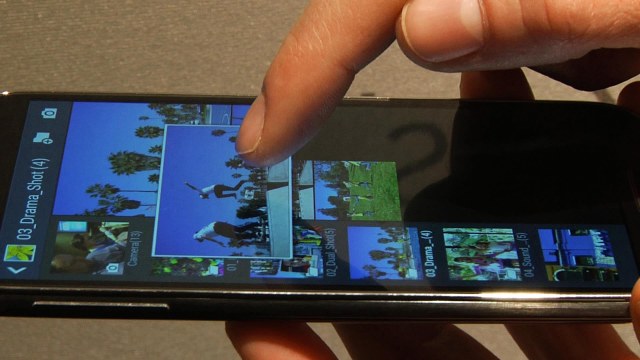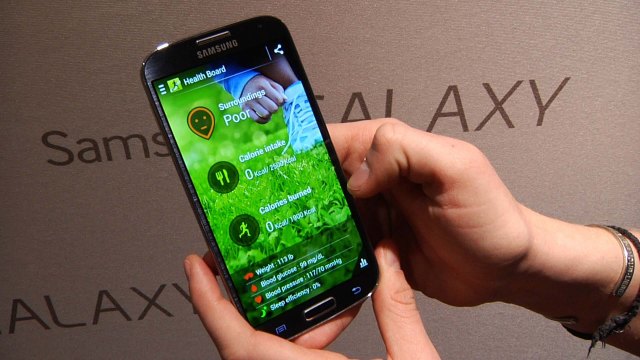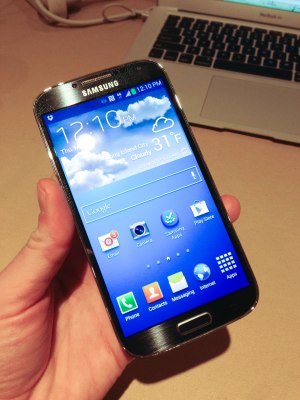As if it could be any other way, the just-announced Samsung Galaxy S 4 is Samsung’s, and perhaps even Android’s, best phone yet. In fact, it very well may be the best smartphone on the market, period.
We’ve been through months of speculation, hype, rumors, and leaks, but the truth is out, and the Galaxy S 4 still has much more up its sleeve than the leaks suggested. More than any other Galaxy before it, the Galaxy S 4 is proof that the company can build a central brand the way Apple has with the iPhone. Both the Galaxy Note and Galaxy S series have been selling in the millions, and the Galaxy S 4 looks like it will hold up that trend.
Even with loads of new software, like an enhanced camera application, hover-style gesture features, and a slew of baked-in apps and services from Samsung, the Galaxy S 4 still brings the heat in the hardware/spec department. Here are the specifics:

The Galaxy S 4 clearly has a small ring of competition in the spec department. The only phones that are on this level are the Xperia Z (1080p 5-inch display, 13mp camera, quad-core Snapdragon S4 Pro CPU) and the HTC One (4.7-inch 1080p display, 1.7GHz Snapdragon 600 quad-core CPU, and an “Ultrapixel” camera) and LG’s Optimus G Pro (1080p 5.5-inch display, quad-core Snapdragon 600, 13-megapixel camera).
Of course, they each have their own pros and cons, but the Galaxy S 4 seems to be the most compact, lightest, and fastest among them. Samsung hasn’t been clear about the exact brand of the processor for the U.S. version, but it did say that it was a quad-core Snapdragon CPU clocked at 1.9GHz, which we believe may be the Snapdragon 600.
However, “processors vary by region,” says Samsung, and the Asian and European version will sport the long-awaited Samsung Exynos 5 Octa eight-core processor.
The Galaxy S 4 design manages to both fit in with the Galaxy S family and stand on its own as a unique breed. For one, Samsung packed a bigger display (5-inches diagonal) into a package that’s actually smaller than before. The GS4 is the same width, slightly shorter, and .7mm thinner than its predecessor.
As such, the bezels on the Galaxy S 4 are slightly thinner on all four sides, which means it’s all screen, all the time. And what a screen it is. The Galaxy S 4 display is 5 inches of unadulterated Super AMOLED 1080p brilliance. Surrounding it, the Galaxy S 4 takes a hybrid shape, something between the straight lines of the Galaxy Note and Galaxy S II with the curved tops, bottoms, and corners of the Galaxy S III. The elongated home button is unmistakably GSIII-style.
The Galaxy S 4 also sticks with familiar materials, and unfortunately that still means a whole lot of plastic. Both the front panel and back panel (which is removable) are made of brushed plastic, but with a textured pattern of tiny circles laid over it. It gives the phone an industrial, textured look, but in reality all you feel is smooth plastic.
Around the edge, you’ll notice a new embellishment to the S series: a metallic bar that runs along the edge of the device. Though it looks a lot like metal, it’s actually polycarbonate and meant to protect the sensitive corners of the device.
It would be nice to see some more premium materials in this generation of the Galaxy S, but the plastic and polycarbonate construction let Samsung fit many components into a very compact, light package, according to Director of Product Planning Drew Blackard.
The Galaxy S 4 uses a new 13-megapixel rear-facing camera, bumped up from the 8-megapixel shooter on the Galaxy S III. It’s still centrally placed on the upper back half of the device, complete with LED flash, autofocus, and 1080p video recording. On the front, the Galaxy S 4 sports a 2-megapixel camera.
The higher megapixel sensor is nice, and will surely make a slight difference, but where the Galaxy S 4 camera really evolves from past generations is in the software.
For one thing, the camera app now uses the same UI as the Galaxy Camera, with a brushed silver finish to the buttons and much simpler navigation. Clicking the mode button along the bottom will bring up a simple scroll wheel full of various modes. When one is highlighted, the menu gives the name as well as a description. More sophisticated users can also see these mode options in a grid view for quick changes.
Along with some of the same modes we’ve seen on both the Galaxy Camera and newer Galaxy smartphones like Beauty Shot, Samsung has added way more modes into the mix. One is called Eraser, and it lets you remove unwanted people from a shot. Samsung says it comes in handy for shots that have been photo-bombed, or tourist shots at busy places. The camera senses any motion that goes through the frame and lets you choose to remove it, as if that person had never walked through your shot of the Eiffel Tower.
The Galaxy S 4 also has a dual-shot mode, which is just a button press away from the main camera interface. This lets you use both the front-facing camera and the rear-facing camera at the same time, for both recording and still captures. There are various filters, such as Oval Blur, Postage Stamp, Cubism, and Split, which give you different options for the theme of your dual-shot creation. You can resize the pop-up picture, and move it around the screen using simple drag and drop tools. It’s pretty amazing.
Some other modes include Drama Shot, which lets you take a succession of photos of some action (like someone skiing down a mountain) and turn them into a composite of the entire sequence, and Sound and Shot, which lets you record up to 9 seconds of audio to pair along with a picture.
Samsung even jumped on the GIF train with the likes of Cinemagraph and Vine to create a gif-making mode, called Cinema Shot. It lets you take a short recording, and then determine which parts of the shot stay still and which parts remain animated. In fact, it’s almost exactly like Cinemagraph.
But Samsung took one step past capture and even built an app called Story Album which lets you create photo albums of special events or trips through templates, and use TripAdvisor to add extra location data to your story. You can even print your album through a partnership with Blurb’s print distribution network.
There’s a lot going on here, so try to keep up. We had recently heard that the GS4’s “wow” factor would be all in the software, and that’s exactly right. Most of TouchWiz is the same, though it seems to get lighter and lighter as the phones get faster. The one very noticeable edition was a set of extra toggle buttons available in the pull-down notifications menu.
Other than those particulars, let’s start with the gesture-based head-tracking stuff.

The most useful new feature of the Galaxy S 4 is Air View. It lets you hover over something on the screen to get an extended pop-up view of what’s inside. For example, if you hover over an email in your inbox, Air View will bring up the first few sentences of that email’s contents. If you hover over an album within the photo gallery, you’ll see nine thumbnails of the contents of that gallery. In fact, if you hover over an image while inside the folder, that particular thumbnail will expand to give you a better view of the particular picture. It’s all very reminiscent of what can be done with recent entries in the Galaxy Note line, except without requiring users to keep track of an S-Pen.
Air View is embedded in the email client, photo gallery, calendar, and a Galaxy S 4-edition of Flipboard, which lets you view and select headlines by hovering over a single tile.
Samsung also added an Air Gesture feature, which lets you control the phone without having to hold it — I could see this being used while driving. You can swipe left and right to switch between web pages, songs, photos in the gallery, etc. and swipe up and down to scroll. You can even accept calls by waving at the phone.
Rumors suggested that Samsung had developed some sort of magic-scroll eye-tracking technology, when in reality the Galaxy S 4 can actually only track your head, very much like the Galaxy S III’s Smart stay feature. The front-facing camera can detect that your head is facing the phone directly, which stops the display from dimming.
In the Galaxy S 4, that technology evolves to automatically pause videos when you turn away from the phone with Smart Pause. As far as scrolling is concerned, if you’re on a page that requires reading or scrolling, the Galaxy S 4 will let you tip the phone forward or backward to scroll (as long as the ff-camera senses that you’re paying attention).
Samsung said that using tilt-gestures as well as “head-tracking” technology to streamline browsing a page was “the most intuitive and natural to the end-consumer.”
As far as NFC is concerned, the GS4 includes S Beam and TecTile integration, but Samsung also lets you pair with up to eight other NFC-devices to run a feature called GroupPlay, which lets you play the same song across eight different devices… to create a party on the go.
Samsung also included an IR blaster on the Galaxy S 4 so that you can use it as a remote for just about any modern television. Called WatchON, it also includes rich information proved by an electronic programming guide.
Along with an updated camera and Story Album, the Galaxy S 4 brings a handful of brand new applications to the Galaxy S family. The first, and possibly most important, is S Translator. S Translator is available in nine languages at launch, including Chinese, English U.S., English British, French, German, Italian, Japanese, Korean and Portuguese.
It is a standalone app that automatically translates information that is typed or copy/pasted into it. S Translator is also embedded in ChatOn, Messaging, and email.
The Galaxy S 4 also has an optical reader which turns analog information into digital, by reading business cards and turning them into address book contacts. S Translator is also embedded into the optical reader, which scans QR codes as well.
ChatOn, Samsung’s own-branded VoIP application, has been updated to include three-way video calls, screen share, and annotations. You can even use the new dual-camera mode to enjoy ChatOn calls.

Samsung has been making a big push in the health department with the new Galaxy S 4, and has thus preloaded the S Health app on the device. The app originally made its debut last July and seemed to focus mainly on linking up with existing health gadgets like fancy scales and blood glucose monitors. This time around, using the Galaxy S 4’s built-in pedometer, S Health tracks your activity throughout the day and knows when you’re running, walking or climbing stairs. The S Health app also lets you input your consumption activities to track caloric intake and get suggestions.
Speaking of S Health, Samsung is selling a few health-related accessories to tackle the ever-growing quantified self products like the Jawbone Up, Nike Fuelband, and FitBit. That said, Samsung has introduced the wrist-worn S Band that tracks activity, temperature and humidity.
Samsung is even going so far as to sell a heart-rate monitor which you can strap on for your daily workouts, and a body scale. All of the accessories come with Bluetooth so they can pair back to your device and be recorded by the S Health app.
And since Samsung loves making special cases for its big-name phones, the Galaxy S 4 had to go big even with its case. It’s called the S View cover, and it has a little screen on the front that reads information from the phone. That way, even though the phone is locked, you can still see the time, SMS notifications, battery status, and choose to accept or ignore incoming calls.
Samsung didn’t specify which technology they used for the cover’s display, or whether or not it needs a charge or takes battery from the S 4, but it wouldn’t surprise me to hear they took a page out of the YotaPhone playbook and are using low-power e-ink here.
Samsung didn’t clarify exact pricing, but said it would go for the same price as a “Samsung premium smartphone”. The Galaxy S III launched in the US at $199 with a 2 year contact.
In terms of availability, they didn’t give a specific release date but did say it would be on store shelves in 2013Q2, at AT&T, Verizon, T-Mobile, Sprint, Cricket and U.S. Cellular.
Samsung is riding high on the success of the Galaxy S III and from what I’ve seen, the Galaxy S 4 is a worthy successor with innovative features packed into a familiar housing. It’s a bit of a shame that Samsung announced the phone without giving a price or release date, but at this point, with Samsung the global sales and innovation leader in smartphones, it can do pretty much whatever it wants.






